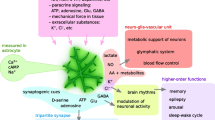Abstract
The effects of cocaine andd-amphetamine, two psychomotor stimulant drugs with pronounced addictive properties, on the electroencephalogram (EEG) of rats were studied by telemetric recordings from the skull in non-anesthetized, freely moving rats. The electrocorticogram (ECoG) was recorded. Both cocaine (10 mg/kg IP) andd-amphetamine (0.4 mg/kg IP) produced a desynchronization, characterized by a general lowering in power in all of the frequency bands. These effects of both drugs were mimicked by the selective agonist at D1 receptors SK&F 38393 (3 mg/kg SC) and were reversed by the antagonist at D1 receptors SCH 23390 (0.2 mg/kg IP) but not influenced by haloperidol (0.1 mg/kg IP) in a dose which is likely to block D2 rather than D1 receptors. These doses of cocaine ord-amphetamine did not produce stereotyped behaviour and slight, if any, increases in locomotor activity only. Large doses of cocaine (30 mg/kg IP) ord-amphetamine (4 mg/kg IP) produced stereotyped behaviour and alterations in EEG which are, based on previous own studies, characteristic for additional stimulation of D2 receptors. This was manifest in a selective increase in power of the alpha-1 band. A similar effect was also produced by the agonist both at D1 and D2 receptors, apomorphine (0.5 mg/kg SC). These results suggest that moderate, but probably rewarding doses of cocaine ord-amphetamine mainly activate D1 dopamine receptors. This activation might be relevant for the rewarding properties of these drugs.
Similar content being viewed by others
References
Ahrens H, Läuter J (1981) Mehrdimensionale Varianzanlayse. Academieverlag, Berlin
Carr GD, Fibiger HC, Phillips AG (1989) Conditioned place preference as a measure of drug reward. In: Liebman JM, Cooper SJ (eds) Topics in experimental neuropharmacology. The neuropharmacological basis of reward. Clarendon, Oxford, pp 264–319
Consolo S, Girotti P, Russi G, DiChiara G (1992) Endogenous dopamine facilitates striatal in vivo acetylcholine release by acting on D1 receptors localized in the striatum. J Neurochem 59:1555–1557
Costall B, Naylor RJ (1973) The role of telencephalic dopaminergic systems in the mediation of apomorphine-stereotyped behaviour. Eur J Pharmacol 24:8–24
DiChiara G, Imperato A (1988) Drugs abused by humans preferentially increase synaptic dopamine concentration in the mesolimbic system of freely moving rats. Proc Natl Acad Sci USA 85:5274–5278
Dimpfel W, Spüler M, Nickel B, Tibes U (1986) “Fingerprints” of central stimulatory drug effects by means of quantitative radioelectroencephalography in the rat (telestero-EEG). Neuropsychobiology 15:101–108
Gottesmann CL, Kirkham PA, LaCoste G Rodrigues L, Arnaud CH (1977) Automatic analysis of the sleep-waking cycle in the rat recorded by miniature telemetry. Brain Res 132:562–568
Hoffman DC, Beninger RJ (1989) The effects of selective D1 or D2 receptor antagonists on the establishment of agonist-induced place conditioning in rats. Pharmacol Biochem Behav 33:273–279
Kebabian JW, Calne DB (1979) Multiple receptors for dopamine. Nature 277:93–96
Koob GF, Le HT, Creese I (1987) The D1 dopamine receptor antagonist SCH 23390 increases cocaine self-administration in the rat. Neurosci Lett 79:315–320
Kropf W, Kuschinsky K (1991) Electroencephalographic correlates of the sedative effects of dopamine agonists presumably acting on autoreceptors. Neuropharmacology 30:953–960
Kropf W, Kuschinsky K (1993) Effects of stimulation of dopamine D1 receptors on the cortical EEG in rats: different influence by a blockade of D2 receptors and by an activation of putative dopamine autoreceptors. Neuropharmacology 32:493–500
Kropf W, Kuschinsky K, Krieglstein J (1989) Apomorphine-induced alterations in cortical EEG activity of rats: involvement of D1 and D2 dopamine receptors. Naunyn-Schmiedeberg's Arch Pharmacol 340:718–725
Leone P, DiChiara G (1987) Blockade of D1 receptors by SCH 23390 antagonizes morphine- and amphetamine-induced place preference conditioning. Eur J Pharmacol 135:251–254
Möller H-G, Nowak K, Kuschinsky K (1987) Conditioning of preand postsynaptic behavioural responses to the dopamine receptor agonist apomorphine in rats. Psychopharmacology 91:50–55
Reavill C, Bond B, Overend P, Hunter AJ (1993) Pharmacological characterization of the discriminative stimulus properties of the dopamine D1 agonist, SKF 81297. Behav Pharmacol 4:135–146
Setler PE, Sarau HM, Zirkle CL, Saunders HL (1978) The central effects of a novel dopamine agonist. Eur J Pharmacol 50:419–430
Sokoloff P, Giros B, Martres M-P, Bouthenet M-L, Schwartz J-C (1990) Molecular cloning and characterization of a novel dopamine receptor (D3) as a taget for neuroleptics. Nature 347:146–151
Stoff LC, Kebabian JW (1984) Two dopamine receptors: biochemistry, physiology and pharmacology. Life Sci 35:2281–2296
Sunahara RK, Guan H-C, O'Dowd BF, Seeman P, Laurier LG, Ng G, George SR, Torchia J, Van Tol HHM (1991) Cloning of a gene for a human dopamine D5 receptor with higher affinity for dopamine than D1. Nature 350:614–619
Tassin J-P, Hervè D, Vezina P, Trovero F, Blanc G, Glowinski J (1991) Relationships between mesocortical and mesolimbic dopamine neurons: functional correlates of D1 receptor heteroregulation. In: Willner P, Scheel-Krüger J (eds) The mesolimbic dopaminergic system: from motivation to action. Wiley, Chichester, pp 175–196
Tsurata K, Frey EA, Grewe CW, Cote TE, Eskay RL, Kebabian JW (1981) Evidence that LY-141865 specifically stimulates the D2 dopamine receptor. Nature 292:463–465
Van Tol HHM, Bunzow JR, Guan H-C, Sunahara RK, Seeman P, Niznik HB, Civelli O (1991) Cloning of the gene for a human dopamine D4 receptor with high affinity for the antipsychotic clozapine. Nature 350:610–614
Zöfel P (1988) Statistik in der Praxis 2. Auflage. Fischer, Stuttgart
Author information
Authors and Affiliations
Rights and permissions
About this article
Cite this article
Ferger, B., Kropf, W. & Kuschinsky, K. Studies on electroencephalogram (EEG) in rats suggest that moderate doses of cocaine ord-amphetamine activate D1 rather than D2 receptors. Psychopharmacology 114, 297–308 (1994). https://doi.org/10.1007/BF02244852
Received:
Revised:
Issue Date:
DOI: https://doi.org/10.1007/BF02244852




